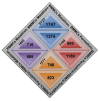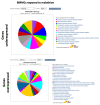Exposure to Insecticides Modifies Gene Expression and DNA Methylation in Hematopoietic Tissues In Vitro
- PMID: 37047231
- PMCID: PMC10094043
- DOI: 10.3390/ijms24076259
Exposure to Insecticides Modifies Gene Expression and DNA Methylation in Hematopoietic Tissues In Vitro
Abstract
The evidence supporting the biological plausibility of the association of permethrin and malathion with hematological cancer is limited and contradictory; thus, further studies are needed. This study aimed to investigate whether in vitro exposure to 0.1 μM permethrin and malathion at 0, 24, 48 and 72 h after cell culture initiation induced changes in the gene expression and DNA methylation in mononuclear cells from bone marrow and peripheral blood (BMMCs, PBMCs). Both pesticides induced several gene expression modifications in both tissues. Through gene ontology analysis, we found that permethrin deregulates ion channels in PBMCs and BMMCs and that malathion alters genes coding proteins with nucleic acid binding capacity, which was also observed in PBMCs exposed to permethrin. Additionally, we found that both insecticides deregulate genes coding proteins with chemotaxis functions, ion channels, and cytokines. Several genes deregulated in this study are potentially associated with cancer onset and development, and some of them have been reported to be deregulated in hematological cancer. We found that permethrin does not induce DNA hypermethylation but can induce hypomethylation, and that malathion generated both types of events. Our results suggest that these pesticides have the potential to modify gene expression through changes in promoter DNA methylation and potentially through other mechanisms that should be investigated.
Keywords: gene expression; malathion; permethrin.
Conflict of interest statement
The authors declare no conflict of interest. The funders had no role in the design of the study; in the collection, analyses, or interpretation of data; in the writing of the manuscript; or in the decision to publish the results.
Figures












Similar articles
-
Systemic pharmacological treatments for chronic plaque psoriasis: a network meta-analysis.Cochrane Database Syst Rev. 2021 Apr 19;4(4):CD011535. doi: 10.1002/14651858.CD011535.pub4. Cochrane Database Syst Rev. 2021. Update in: Cochrane Database Syst Rev. 2022 May 23;5:CD011535. doi: 10.1002/14651858.CD011535.pub5. PMID: 33871055 Free PMC article. Updated.
-
Systemic pharmacological treatments for chronic plaque psoriasis: a network meta-analysis.Cochrane Database Syst Rev. 2020 Jan 9;1(1):CD011535. doi: 10.1002/14651858.CD011535.pub3. Cochrane Database Syst Rev. 2020. Update in: Cochrane Database Syst Rev. 2021 Apr 19;4:CD011535. doi: 10.1002/14651858.CD011535.pub4. PMID: 31917873 Free PMC article. Updated.
-
Systemic pharmacological treatments for chronic plaque psoriasis: a network meta-analysis.Cochrane Database Syst Rev. 2017 Dec 22;12(12):CD011535. doi: 10.1002/14651858.CD011535.pub2. Cochrane Database Syst Rev. 2017. Update in: Cochrane Database Syst Rev. 2020 Jan 9;1:CD011535. doi: 10.1002/14651858.CD011535.pub3. PMID: 29271481 Free PMC article. Updated.
-
Short-Term Memory Impairment.2024 Jun 8. In: StatPearls [Internet]. Treasure Island (FL): StatPearls Publishing; 2025 Jan–. 2024 Jun 8. In: StatPearls [Internet]. Treasure Island (FL): StatPearls Publishing; 2025 Jan–. PMID: 31424720 Free Books & Documents.
-
EORTC guidelines for the use of erythropoietic proteins in anaemic patients with cancer: 2006 update.Eur J Cancer. 2007 Jan;43(2):258-70. doi: 10.1016/j.ejca.2006.10.014. Epub 2006 Dec 19. Eur J Cancer. 2007. PMID: 17182241
Cited by
-
Comparative toxicotranscriptomics of longterm cypermethrin exposure to aquacultured fish Labeo catla (Catla).Sci Rep. 2025 Mar 19;15(1):9479. doi: 10.1038/s41598-025-86513-x. Sci Rep. 2025. PMID: 40108230 Free PMC article.
-
Associations between pesticide use and rheumatoid arthritis among older farmers in the Agricultural Health Study.Sci Rep. 2024 Dec 2;14(1):29978. doi: 10.1038/s41598-024-76179-2. Sci Rep. 2024. PMID: 39622868 Free PMC article.
-
Occupational Exposure to Pesticides Among Farmworkers in Morocco: A Study Framework for Endocrine and Epigenetic Effect Assessment.Toxics. 2025 Apr 25;13(5):340. doi: 10.3390/toxics13050340. Toxics. 2025. PMID: 40423419 Free PMC article.
-
Environmental Pollution and Risk of Childhood Cancer: A Scoping Review of Evidence from the Last Decade.Int J Mol Sci. 2024 Mar 14;25(6):3284. doi: 10.3390/ijms25063284. Int J Mol Sci. 2024. PMID: 38542255 Free PMC article.
References
-
- Matthews G. Pesticides: Health, Safety and the Environment. 2nd ed. Wiley; Hoboken, NJ, USA: 2016. [(accessed on 16 December 2022)]. Available online: https://www.wiley.com/en-us/Pesticides%3A+Health%2C+Safety+and+the+Envir....
-
- Lu C., Liu X., Liu C., Wang J., Li C., Liu Q., Li Q., Li S., Sun S., Yan J., et al. Chlorpyrifos induces MLL translocations through caspase 3-dependent genomic instability and topoisomerase II inhibition in human fetal liver hematopoietic stem cells. Toxicol. Sci. Off. J. Soc. Toxicol. 2015;147:588–606. doi: 10.1093/toxsci/kfv153. - DOI - PubMed
MeSH terms
Substances
Grants and funding
LinkOut - more resources
Full Text Sources

